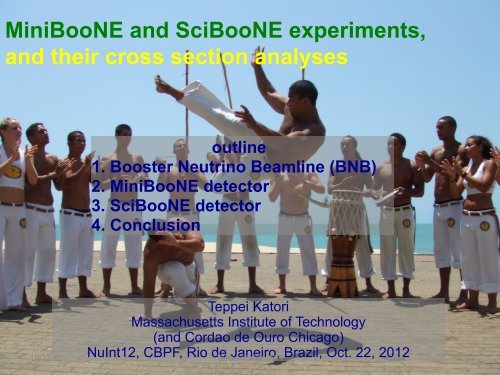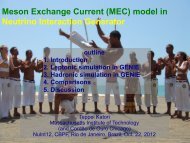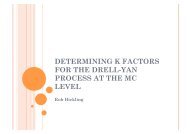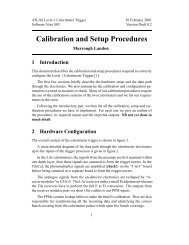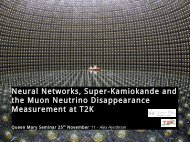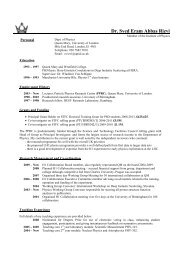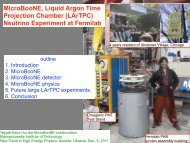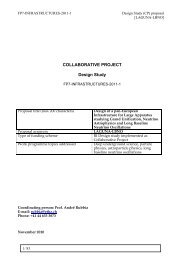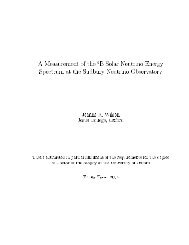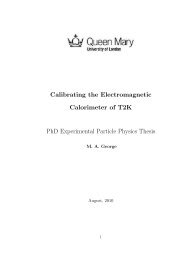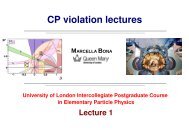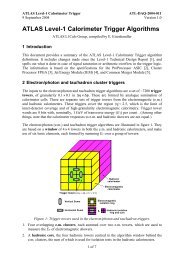1. Booster Neutrino Beamline - Indico - Fermilab
1. Booster Neutrino Beamline - Indico - Fermilab
1. Booster Neutrino Beamline - Indico - Fermilab
- No tags were found...
Create successful ePaper yourself
Turn your PDF publications into a flip-book with our unique Google optimized e-Paper software.
<strong>Booster</strong> Rookie bookhttp://www-bdnew.fnal.gov/operations/rookie_books/rbooks.html<strong>1.</strong> <strong>Booster</strong> <strong>Neutrino</strong> <strong>Beamline</strong><strong>Fermilab</strong> <strong>Booster</strong>- Constructed in 1970- 150m diameter proton synchrotron- 24 superperiods, 18 RFs- 400MeV H - injection from LINAC<strong>Booster</strong> injection areastripping foilSciBooNEMiniBooNE<strong>Booster</strong> schematics<strong>Booster</strong>magnet (p)Injection linefrom LINAC (H - )10/22/12Teppei Katori, MITstripping foil4
<strong>Booster</strong> Rookie bookhttp://www-bdnew.fnal.gov/operations/rookie_books/rbooks.html<strong>1.</strong> <strong>Booster</strong> <strong>Neutrino</strong> <strong>Beamline</strong><strong>Fermilab</strong> <strong>Booster</strong>- Constructed in 1970- 150m diameter proton synchrotron- 24 superperiods, 18 RFs- 400MeV H - injection from LINAC- Combined magnet, with vacuum inside- Not FODO cell (FOFDOOD)SciBooNE<strong>Booster</strong> magnetMiniBooNE<strong>Booster</strong> lattice10/22/12 Teppei Katori, MIT5
<strong>Booster</strong> Rookie bookhttp://www-bdnew.fnal.gov/operations/rookie_books/rbooks.html<strong>1.</strong> <strong>Booster</strong> <strong>Neutrino</strong> <strong>Beamline</strong><strong>Fermilab</strong> <strong>Booster</strong>- Constructed in 1970- 150m diameter proton synchrotron- 24 superperiods, 18 RFs- 400MeV H - injection from LINAC- Combined magnet, with vacuum inside- Not FODO cell (FOFDOOD)- 33ms acceleration, 20k turns, from 400MeV to 8GeV- 84 harmonics (maximum 84 bunches)- 3 bunches are removed, so usually 81 bunches- 81 bunches separate with 19ns, making <strong>1.</strong>6µs spillSciBooNE MRD neutrino induced muonsSciBooNE<strong>Booster</strong> RF cavityMiniBooNE<strong>1.</strong>5~81 bunches19nsBeam micro structure<strong>1.</strong>6µs10/22/12 Teppei Katori, MIT20µsBeam macro structure6
<strong>Booster</strong> Rookie bookhttp://www-bdnew.fnal.gov/operations/rookie_books/rbooks.html<strong>1.</strong> <strong>Booster</strong> <strong>Neutrino</strong> <strong>Beamline</strong>SciBooNE<strong>Fermilab</strong> <strong>Booster</strong>- Constructed in 1970- 150m diameter proton synchrotron- 24 superperiods, 18 RFs- 400MeV H - injection from LINAC- Combined magnet, with vacuum inside- Not FODO cell (FOFDOOD)- 33ms acceleration, 20k turns, from 400MeV to 8GeV- 84 harmonics (maximum 84 bunches)- 3 bunches are removed, so usually 81 bunches- 81 bunches separate with 19ns, making <strong>1.</strong>6µs spill- Nominal run, ~5 spills fast extraction per second (5Hz)- 5E12 ppp (proton per pulse)- POT is measured at 2 locations by toroids, one is official, other is crosscheck, and the difference of them is the 2% POT normalization errorMiniBooNE10/22/12 Teppei Katori, MIT7
MiniBooNE flux prediction summary paperPRD79(2009)072002<strong>1.</strong> <strong>Booster</strong> <strong>Neutrino</strong> <strong>Beamline</strong>SciBooNETarget and magnetic horn- Longest life time horns! (lower current?)- Beryllium target (71 cm), 7 “slugs”- Vibration of the horn is audible- Magnetic focussing horn run at ~174kA (or -174kA)- Surface current of the horn affect B-field distribution, hence secondary particle trajectory.It affects not only normalization, but also shape of spectrum- In total, beamline simulation (except meson production errors) makes ~4-8%normalization and shape errorMagnetic focusing hornMiniBooNEBeryllium target10/22/12 Teppei Katori, MIT8
MiniBooNE flux prediction summary paperPRD79(2009)072002<strong>1.</strong> <strong>Booster</strong> <strong>Neutrino</strong> <strong>Beamline</strong>Secondary meson distribution- The most important to understand ν-flux- BNB uses GEANT4 simulation- BNB relies on HARP data for inputs- So far only 1 slug target data (“thin” target data) isanalysed, but the secondary scattering by 7 slugs (“thick”target) is believed to be small effect, and believed to besmall error(HARP thick target data is being analysed nowby Athula Wickramasinghe, U-Cincinnati)HARP experiment (CERN)HARP collaboration,Eur.Phys.J.C52(2007)29Pavlovic,PhD thesisSciBooNEMiniBooNEFraction oftertiary π +production10/22/12 Teppei Katori, MITBNB T2K NuMI9
MiniBooNE flux prediction summary paperPRD79(2009)072002<strong>1.</strong> <strong>Booster</strong> <strong>Neutrino</strong> <strong>Beamline</strong>SciBooNEMiniBooNESecondary meson distribution- The most important to understand ν-flux- BNB uses GEANT4 simulation- BNB relies on HARP data for inputs- So far only 1 slug target data (“thin” target data) isanalysed, but the secondary scattering by 7 slugs (“thick”target) is believed to be small effect, and believed to be small error- π + /π - -decay neutrinos are dominant, hence small K-decay error- small HARP measurement error (5-7%) is directly applied for Eν=0.5-<strong>1.</strong>0GeV- HARP has larger error at high E measurement, and hence high Eν prediction has larger error- Low Eν prediction relies on extrapolation, and hence larger error- In total, meson production give ~5-8% normalization errorBNB pion kinematic spaceHARP kinematiccoverage (>80%)HARP data with 8.9 GeV/c proton beammb10/22/12 Teppei Katori, MITp π (GeV)10
<strong>1.</strong> <strong>Booster</strong> <strong>Neutrino</strong> <strong>Beamline</strong>SciBooNEMiniBooNESecondary meson distribution- The most important to understand ν-flux- BNB uses GEANT4 simulation- BNB relies on HARP data for inputs- So far only 1 slug target data (“thin” target data) isanalysed, but the secondary scattering by 7 slugs (“thick”target) is believed to be small effect, and believed to be small error- π + /π - -decay neutrinos are dominant, hence small K-decay error- small HARP measurement error (5-7%) is directly applied for Eν=0.5-<strong>1.</strong>0GeV- HARP has larger error at high E measurement, and hence high Eν prediction has larger error- Low Eν prediction relies on extrapolation, and hence larger error- In total, meson production give ~5-8% normalization errorIn summary, neutrino flux prediction has ~6-12% normalization error with small shape errorMore on beam systematics,see Hartz’s talk on Friday10/22/12 Teppei Katori, MIT11
MiniBooNE collaborationPRD84(2011)072005<strong>1.</strong> <strong>Booster</strong> <strong>Neutrino</strong> <strong>Beamline</strong>SciBooNEMiniBooNESecondary meson distribution- The most important to understand ν-flux- BNB uses GEANT4 simulation- BNB relies on HARP data for inputs- So far only 1 slug target data (“thin” target data) isanalysed, but the secondary scattering by 7 slugs (“thick”target) is believed to be small effect, and believed to be small error- π + /π - -decay neutrinos are dominant, hence small K-decay error- small HARP measurement error (5-7%) is directly applied for Eν=0.5-<strong>1.</strong>0GeV- HARP has larger error at high E measurement, and hence high Eν prediction has larger error- Low Eν prediction relies on extrapolation, and hence larger error- In total, meson production give ~5-8% normalization errorIn summary, neutrino flux prediction has ~6-12% normalization error with small shape errorAnti-neutrino cross section measurement- For anti-neutrino mode analysis, errors from neutrino contamination in anti-neutrino beamcontribute additional ~5% normalization error through background subtractionAnti-neutrino xs systematics,see Grange’s talk on Thursday10/22/12 Teppei Katori, MIT12
<strong>1.</strong> <strong>Booster</strong> <strong>Neutrino</strong> <strong>Beamline</strong> (BNB)2. MiniBooNE detector3. SciBooNE detector4. Conclusion10/22/12 Teppei Katori, MIT 13
2. MiniBooNE detectorMiniBooNE run is over!- 2002 to 2012 (proposals prepared for further running)- extremely stable running over 10 years- energy scale is stable within 1%- <strong>Neutrino</strong> rate is stable with 2%Reconstructed neutrino energyCheckered flag on MiniBooNE detector hall<strong>Neutrino</strong> (antineutrino) event rate/POT10/22/12 Teppei Katori, MIT14
MiniBooNE collaboration,PRD81(2010)0920052. MiniBooNE detectorMiniBooNE, as a Cherenkov detector- 12 m diameter spherical tank- 800t of pure mineral oil (from Exxon)- 1280 inner 8-inch PMTs- 240 veto 8-inch PMTs- Detector errors are smallcomparing with flux error,total normalization error is 4-5%- But it has large shape errorCCQE flux-unfolded total cross sectionfractional shape error10/22/12 Teppei Katori, MIT 15
Perevalov, PhD thesisPRD82(2010)0920052. MiniBooNE detectorMiniBooNE, as a scintillation detector- Scintillation from the mineral oil represent total deposit energy (nuclear effect-free!)- Light propagation model creates large source of uncertainty- NCEL measurement is limited by this detector error (16%)Light extinction rate for each absorptionspectrum in mineral oilScintillation parameter (arbitrary unit)NC elastic scintillation light fractionwith various light propagation modelsprotonCherenkovthreshold10/22/12 Teppei Katori, MIT16
Tayloe, <strong>Fermilab</strong> 2012PAC presentation2. MiniBooNE detectorMiniBooNE, as a scintillation detector- Scintillation from the mineral oil represent total deposit energy (nuclear effect-free!)- Light propagation model creates large source of uncertainty- NCEL measurement is limited by this detector error (16%)Adding scintillator in MiniBooNE detector?- Proposal is considered- Possible to detect 2.2MeV γ from neutron capture- 300kg of PPO ($75k) can do thatPhysics- Improve NCEL measurement- Can distinguish ν e CCQE from NC processes (NCγ, NCπ o ) by neutron tagging- ν µ +Càµ+N g.s. measurement by N g.s. β-decay- Eν reconstruction by total scintillation lightEν calibration by scintillation light,see Tzanov’s talk on today10/22/12 Teppei Katori, MITEν (GeV)17
Nelson, PhD thesisPRD83(2011)0520092. MiniBooNE detectorNuclear effects in the MiniBooNE detector- Cross section model error only affect background subtraction- All cross sections are defined by final state particles, hence MiniBooNE cross sectionmeasurement has no intra-nuclear effect error- However propagation of particles in the detector is also affected by nuclear effect (e.g.,pion absorption by oil, etc) and this have to be modelled, and corrected. CC1π o productionmeasurement is limited by this (13%)Signalν pν π ο µSignalppionproductionin nucleipNot signalν π ο µppionabsorptionin nucleiπ ο µSignal µν ppionabsorptionin oilπ ο 10/22/12 Teppei Katori, MIT18
Nelson, PhD thesisPRD83(2011)0520092. MiniBooNE detectorNuclear effects in the MiniBooNE detector- Cross section model error only affect background subtraction- All cross sections are defined by final state particles, hence MiniBooNE cross sectionmeasurement has no intra-nuclear effect error- However propagation of particles in the detector is also affected by nuclear effect (e.g.,pion absorption by oil, etc) and this have to be modelled, and corrected. CC1π o productionmeasurement is limited by this (13%)GCALOR-data comparison- pion charge exchange in the detector à 50%- pion absorption in the detector à 35%Signal µν ppionabsorptionin oilπ ο 10/22/12 Teppei Katori, MIT 19
Anderson, PhD thesisPRD81(2010)0330042. MiniBooNE detectorMiniBooNE data unfolding error- Extracted cross section depends how to unfold, hence there is unfolding error- Most of MiniBooNE xs data rely on Iterative Bayesian unfolding method, which dependson cross section model, but model dependency is corrected by iterative process- There is no perfect unfolding method (small bias doesn’t mean better)NC1π o production momentum distribution (GeV/c)NC1π o production angular distribution10/22/12 Teppei Katori, MIT 20
<strong>1.</strong> <strong>Booster</strong> <strong>Neutrino</strong> <strong>Beamline</strong> (BNB)2. MiniBooNE detector3. SciBooNE detector4. Conclusion10/22/12 Teppei Katori, MIT 21
3. SciBooNE detectorSciBooNE detectorThe SciBooNE detector consists of3 major components Muon RangeDetector (MRD)ν beamSciBarElectron Catcher(EC)10/22/12 Teppei Katori, MIT 22
3. SciBooNE detectorSciBar detector- 14,366 channel X-Y tracker ofextruded scintillators with WLS fiberreadout by multi-anode PMT.Electron catcher (EC)- 11 radiation length E&Mcalorimeter with scintillationfibers and lead foil.Extrudedscintillator(15t)Multi-anodePMT (64 ch.)ν 3mWave-lengthshifting fiber<strong>1.</strong>7mMuon Range Detector (MRD)- Iron plates with X-Y scintillator panels- measure the muon momentum up to0.9GeV, with 10% resolution.10/22/12 Teppei Katori, MIT 23
3. SciBooNE detectorExtruded scintillation bar- Polystyrene (PS), 1% PPO and 0.03% POPOP- TiO 2 is merged in outer layer as a reflector- hole for WLS fiber- ~20 p.e. for MIP particle- K2K, MINOS, SciBooNE, MINERvA, T2K...Wave length shifting (WLS) fiber- Absorb blue light, emit green lightExtruded scintillator production machine (<strong>Fermilab</strong>) (1)chargedparticle(2)scintillationlight (blue)(3)Shifted light(green)PMT10/22/12 Teppei Katori, MIT 24
3. SciBooNE detectorSciBar tracking ability- Particle tracks are clearly seenSciBooNE CCQE candidateν+p→n+µ +candidaten p μp ν+n→p+µ -candidateμμSciBar EC MRDSciBar EC MRD10/22/12 Teppei Katori, MIT 26
Hiraide, PhD thesisPRD78(2008)1120043. SciBooNE detectorIt is extremely difficult to be right for all samples, 1 track, 2 track, µ+p, etc...- Within detector systematics, cross section model errors, nuclear effect errors,MC is tuned to match with datae.g.) CC1π + production measurement analysis- 8 parameter controls total normalization, migrations, scale of some channels- Best fit MC is used for background subtractionSciBooNE CC1π + analysis flowchartBest fit values10/22/12 Teppei Katori, MIT 27
Nakajima, PhD thesis,PRD83(2011)0120053. SciBooNE detectorSciBooNE cross section model error- Unlike MiniBooNE, cross section model errors are includede.g.) CC inclusive cross section- MC template in P µ -θ µ space is used to extract total cross sectionP µ -θ µ space MC template in Eν binExtracted total cross sectionSciBar stop<strong>1.</strong>00-<strong>1.</strong>25 GeVMRD stop<strong>1.</strong>00-<strong>1.</strong>25 GeVSciBar stop<strong>1.</strong>25-<strong>1.</strong>75 GeVMRD stop<strong>1.</strong>25-<strong>1.</strong>75 GeV10/22/12 Teppei Katori, MIT 28
Kurimoto, PhD thesisPRD81(2010)111102(R)3. SciBooNE detectorVertex activity- Energy deposit around the vertex can be measured.- Especially powerful to study nuclear break-up (i.e. coherent reaction)e.g.) NCπ o coherent fraction measurementSciBooNE NC1π o event displayNCπ o vertex activity10/22/12 Teppei Katori, MIT 29
4. ConclusionFlux error- <strong>Neutrino</strong> flux prediction is the largest normalization error- Among them, meson production model has the largest errorMiniBooNE detector- Detector error is in general small (except NCEL and CCπ o )- FSI in the target nucleus are not source of error- Cross section model error is applied only to background channelsSciBooNE detector- FSI in the target nucleus is source of error- Cross section model error is applied to signal channel- Vertex activity is the powerful tool to study nuclear break-upMuito obrigado!3010/22/12 Teppei Katori, MIT
Backup10/22/12 Teppei Katori, MIT 31
3. SciBooNE detector all around the worldSciBarECMRDSciBar Production(<strong>Fermilab</strong>, USA)2003SciBooNE(<strong>Fermilab</strong>, USA)2007CHORUS(CERN, Switzerland)1994HARP(CERN, Switzerland)2001Solar neutron(Puebla, Mexico)2011MRD production(<strong>Fermilab</strong>, USA)2007EC Production(INFN, Italy)1991K2K(KEK, Japan)200310/22/12 Teppei Katori, MIT 32
3. SciBooNE detector all around the worldSciBarECMRDSciBar Production(<strong>Fermilab</strong>, USA)2003SciBooNE(<strong>Fermilab</strong>, USA)2007CHORUS(CERN, Switzerland)1994HARP(CERN, Switzerland)2001Solar neutron(Puebla, Mexico)2011MRD production(<strong>Fermilab</strong>, USA)2007EC Production(INFN, Italy)1991K2K(KEK, Japan)2003DOE-wide Pollution Prevention Star (P2 Star) Award10/22/12 Teppei Katori, MIT 33
3. SciBooNE detector all around the worldSciBarECMRDSciBar Production(<strong>Fermilab</strong>, USA)2003SciBooNE(<strong>Fermilab</strong>, USA)2007CHORUS(CERN, Switzerland)1994HARP(CERN, Switzerland)2001Solar neutron(Puebla, Mexico)2011MRD production(<strong>Fermilab</strong>, USA)2007SciBooNE time scaleEC Production(INFN, Mar. Italy) 2005 K2K endsK2K1991 Nov. 2005 SciBooNE is proposed(KEK, Japan)Dec. 2005 Approved2003Jul. 2006 SciBar arrived from JapanSep. 2006 GroundbreakingApr. 2007 SciBar assembly completedJun. 2007 SciBooNE started to beam dataAug. 2008 Run endDOE-wide Pollution Prevention Star (P2 Star) Award10/22/12 Teppei Katori, MIT 34


